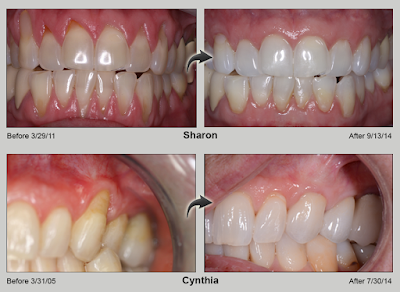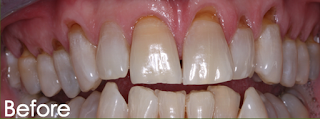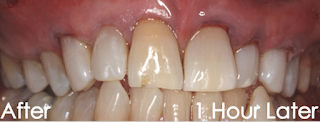Laser dentistry is incredibly versatile and plays an important role in a growing number of common dental procedures. Though laser dentistry is most notably associated with cosmetic treatments, it is equally effective for preventative purposes.
Here are some of the ways that dental lasers can be used:
Tooth preparation – Prior to laser dentistry, a drill would be required to prepare the tooth for a filling. Lasers can now completely eliminate the need for drilling and anesthesia. Lasers also successfully kill oral bacteria around the surgical site.
Reshaping soft tissue – Dental lasers can dissolve soft tissue to expose more of the natural tooth (crown lengthening), reshape soft tissue to make “gummy smiles” more attractive, and remove uncomfortable soft tissue folds caused by denture wear.
Frenectomy – Lasers can improve speech and the feeding habits of babies, children and adults by untying the tongue.
Tumor removal – When benign tumors have formed in the soft tissue areas of the mouth, a dental laser can completely remove them without causing pain. Whitening – Lasers can greatly expedite the tooth whitening process by increasing the activity of the particles in the peroxide bleaching solution.
Biopsy – Lasers are sometimes used to perform a biopsy on suspicious areas of soft tissue. This biopsy procedure can be performed instantly and with great precision
Wednesday, July 20, 2016
Wednesday, June 22, 2016
What are the differences between an Orthodontist, Dentist, and Periodontist?
All are dentists who specialize in oral care, and all are technically dentists.
Orthodontists complete an additional two – three years of training in orthodontics, above and beyond general dentistry
Periodontists complete and additional two – three years training to specialize in all areas of general dentistry for children
All orthodontists are dentists, but only 10 percent of dentists are orthodontists. Orthodontists limit their practice to moving teeth and correcting jaw irregularities
Dentists and Periodontists refer their patients to an orthodontist if they have problems with the alignment of their teeth or a bite abnormality of some kind. The same as a physician would refer you to a cardiologist or orthopedists if you had heart or skeletal issues.
It is important to understand the differences in treatment delivery and care! At Lubbock Periodontics all we specialize in periodontics, all day long, day in a day out, with thousands of beautiful smiles to testify over the years. For further questions, or to schedule an appointment, contact our office at (806) 794-8365.
Wednesday, June 8, 2016
Ask A Professional: Who Should Treat My Periodontal Disease?
Who should treat my periodontal disease: my general dentist or a periodontist?
When it comes to your oral health problems, taking a serious approach to treatment should be your first priority. Several people struggle with what to do when deal with periodontal disease, and aren't sure where to turn. Instead of leaving your periodontal treatment to one dental professional, you really should have both your general dentist and periodontist actively involved in your diagnosis and treatment as a team.
Your general dentist is familiar with your dental and medical history, and can help your periodontist in that aspect. Your periodontist, has all of the general dentist training and background, yet specializes with extensive experience in treating periodontal disease. Together, they can collaborate to tailor your treatment for your individual needs.
When you visit our Lubbock, TX dental office, your smile is our top priority. Dr. Wentz and her entire team are dedicated to providing you with the personalized, quality dental care that you deserve.
When you visit our Lubbock, TX dental office, your smile is our top priority. Dr. Wentz and her entire team are dedicated to providing you with the personalized, quality dental care that you deserve.
Thursday, May 19, 2016
Do You Know Why Your Gums Are Bleeding?
Improper or inconsistent dental hygiene can lead to bacteria buildup in the mouth, which results in red, swollen, and bleeding gums. This condition, called gingivitis, is quite common, and is not particularly painful for many people. If left untreated, however, gingivitis can lead to periodontitis, which is a serious condition that can lead to tooth loss.
What Is Gingivitis?
Gingivitis will cause your gums to become red, swollen, and soft, instead of pink and firm. Your gums may bleed when you brush your teeth and/or floss, you could also have persistent bad breath. Gingivitis is caused by poor oral hygiene habits. Oral bacteria continuously form a sticky substance called plaque. If the plaque isn’t brushed off or flossed away quickly, it will harden into a substance called tartar. The presence of both plaque and tartar will irritate that part of your gums (like a splinter) and lead to gingivitis. Plaque also causes tooth decay. The good news is that if you catch gingivitis in its early stages and practice proper dental hygiene, you can reverse the effects.
You are at a risk for gingivitis if you:
One of the common things you hear people say is that they don’t floss because it makes their gums bleed. However, it’s very important to floss at least twice a day to remove the plaque that can’t be reached by a tooth brush. Even if you already have gingivitis, you should continue to floss so that plaque doesn’t have a chance to turn to tartar, which can eventually lead to periodontitis if it’s not removed. Once you’ve been brushing and flossing regularly, your gums should return to a healthy pink, and you should not see bleeding.
Tartar? Time to See a Dr. Lisa Wentz of Lubbock Periodontics
What Is Gingivitis?
Gingivitis will cause your gums to become red, swollen, and soft, instead of pink and firm. Your gums may bleed when you brush your teeth and/or floss, you could also have persistent bad breath. Gingivitis is caused by poor oral hygiene habits. Oral bacteria continuously form a sticky substance called plaque. If the plaque isn’t brushed off or flossed away quickly, it will harden into a substance called tartar. The presence of both plaque and tartar will irritate that part of your gums (like a splinter) and lead to gingivitis. Plaque also causes tooth decay. The good news is that if you catch gingivitis in its early stages and practice proper dental hygiene, you can reverse the effects.
You are at a risk for gingivitis if you:
- have diabetes
- are older
- don’t brush and floss regularly
- have a suppressed immune system
- take certain medications
- abuse drugs or alcohol
- have dry mouth
- are pregnant
One of the common things you hear people say is that they don’t floss because it makes their gums bleed. However, it’s very important to floss at least twice a day to remove the plaque that can’t be reached by a tooth brush. Even if you already have gingivitis, you should continue to floss so that plaque doesn’t have a chance to turn to tartar, which can eventually lead to periodontitis if it’s not removed. Once you’ve been brushing and flossing regularly, your gums should return to a healthy pink, and you should not see bleeding.
Tartar? Time to See a Dr. Lisa Wentz of Lubbock Periodontics
If you notice blood during and after brushing or flossing, you should make an appointment with your Dr. Lisa Wentz. Your oral health is very important to your overall health, so call her today to set up an appointment.
Thursday, April 21, 2016
Sinus Augmentation
There are many reasons why the gums and jawbone may require corrective treatment, including periodontal disease, trauma and birth defects. Periodontal disease particularly, can greatly disfigure the natural appearance of the gums and teeth and give the smile an unaesthetic appearance.
Learn more about this common jawbone treatment: Sinus Augmentation.
Sinus Augmentation
Learn more about this common jawbone treatment: Sinus Augmentation.
Sinus Augmentation
This procedure is usually performed prior to the placement of dental implants, to ensure that the prosthetic teeth are both functional and firmly affixed to the bone. The success of an implant hinges on the quantity and quality of the jawbone to which it will be attached. If the jawbone has receded or been injured, a sinus augmentation can slightly elevate the sinus floor to allow new bone to form. Generally, a small incision is made in the bone and the underlying space is packed with grafting material. The incision is sutured closed, and the implant will be placed when healing has occurred.
If you have questions or concerns regarding Gum or Jawbone corrective treatments please ask your dentist.
If you have questions or concerns regarding Gum or Jawbone corrective treatments please ask your dentist.
Tuesday, March 15, 2016
Pinhole Surgical Technique Now Offered at Lubbock Periodontics
The Pinhole Surgical Technique is now offered by Dr. Lisa Wentz of Lubbock Periodontics. This procedure was invented by Dr. John Chao, offering patients a scalpel-free, suture free and conventional graft free way to correct gum recession.
The process is as simple as this:
Dr. Wentz will use specially designed instruments to loosen gum tissue and glide over receded parts of the tooth through a small hold made by a needle. There is no cutting, stitching, and patients can expect very minimal post-operative symptoms. The procedure typically takes 1-2 hours and usually in most cases, patients are back to their regular daily routines the next day.
Check out some before & after photos taken from pinholesurgicaltechnique.com:
The process is as simple as this:
Dr. Wentz will use specially designed instruments to loosen gum tissue and glide over receded parts of the tooth through a small hold made by a needle. There is no cutting, stitching, and patients can expect very minimal post-operative symptoms. The procedure typically takes 1-2 hours and usually in most cases, patients are back to their regular daily routines the next day.
Check out some before & after photos taken from pinholesurgicaltechnique.com:
Are you interested in having this procedure done in the Lubbock area? Contact Lubbock Periodontics and schedule a consultation with Dr. Lisa Wentz.
Thursday, March 10, 2016
Pinhole Surgical Technique by Dr. Lisa Wentz
The process is as simple as this:
Dr. Wentz will use specially designed instruments to loosen gum tissue and glide over receded parts of the tooth through a small hold made by a needle. There is no cutting, stitching, and patients can expect very minimal post-operative symptoms. The procedure typically takes 1-2 hours and usually in most cases, patients are back to their regular daily routines the next day.
Check out some before & after photos taken from pinholesurgicaltechnique.com:
 |
| www.pinholesurgicaltechnique.com |
 |
| www.pinholesurgicaltechnique.com |
Subscribe to:
Comments (Atom)









